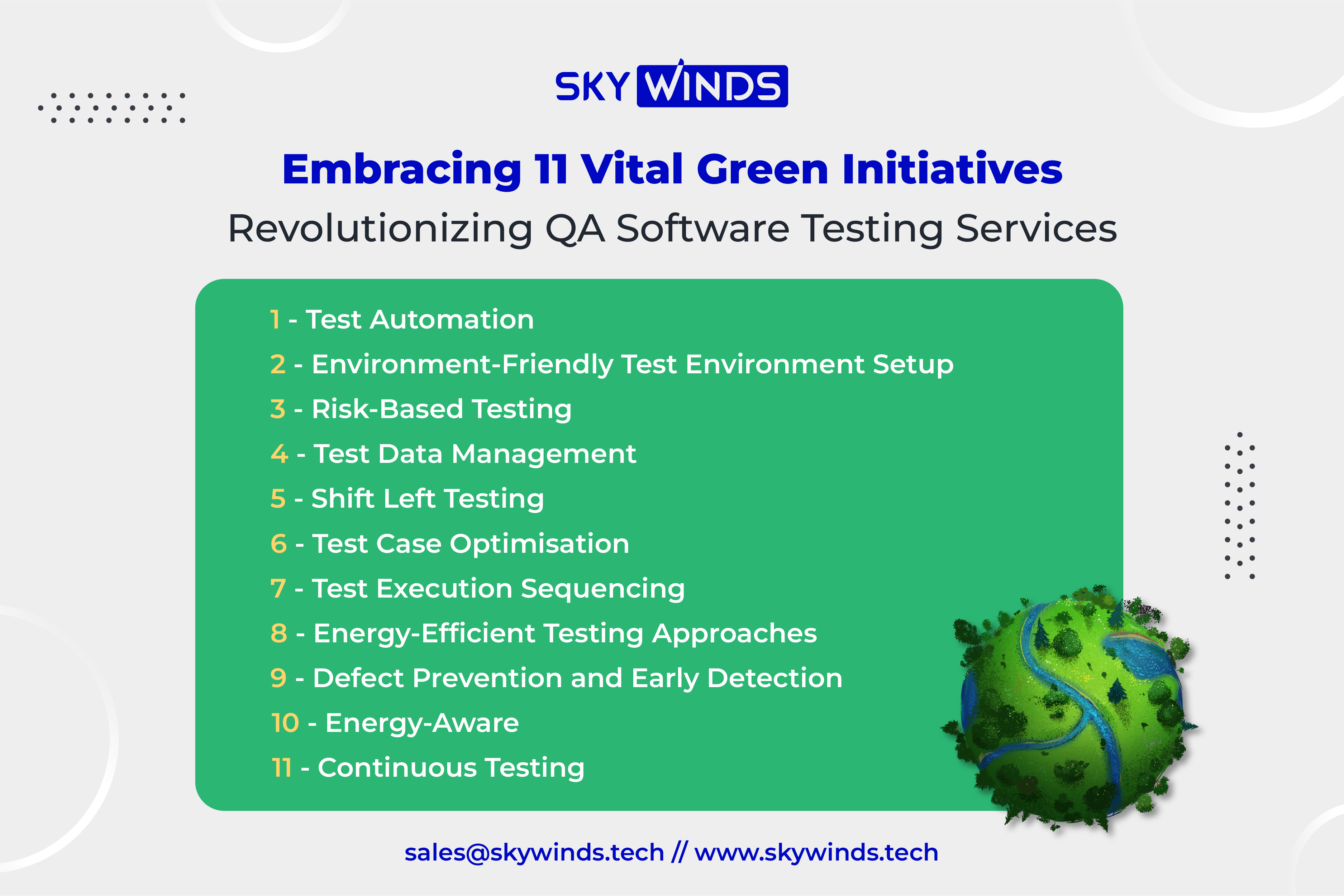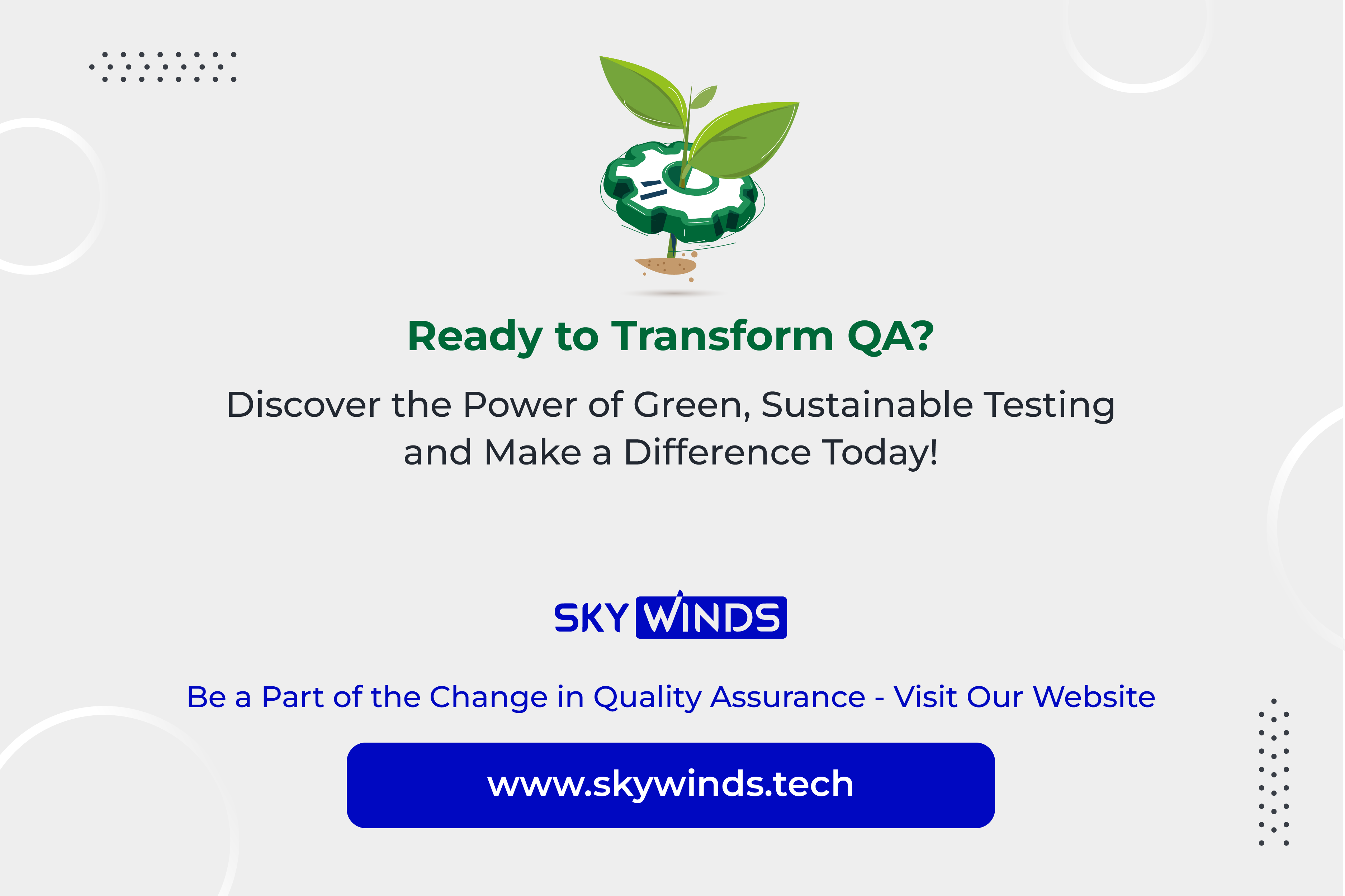
In an era where environmental consciousness and sustainability have become paramount, businesses across all industries are re-evaluating their practices to embrace greener initiatives. The field of software quality assurance (QA) is no exception. As organizations strive to reduce their carbon footprint and adopt eco-friendly approaches, Green Sustainable Testing has emerged as a pivotal aspect of software development.
This paradigm shift in QA practices seeks to harmonize the pursuit of efficient software delivery with environmental responsibility. This article delves into the innovative ways green initiatives reshape software QA practices, propelling the industry towards a more eco-conscious and sustainable future. So, without further ado, Let’s dive straight into the details.
Table of Contents
- What is Green Sustainable Testing?
- Initiatives Which are Reshaping Green Sustainable Testing QA Practices
- 1. Green Sustainable Testing Automation
- 2. Environment-Friendly Test Environment Setup
- 3. Risk-Based Green Sustainable Testing
- 4. Green Sustainable Testing Data Management
- 5. Shift Left Green Sustainable Testing
- 6. Green Sustainable Testing Case Optimization
- 7. Green Sustainable Testing Execution Sequencing
- 8. Energy-Efficient Green Sustainable Testing Approaches
- 9. Defect Prevention and Early Detection
- 10. Energy-Aware Green Sustainable Testing
- 11. Continuous Testing
- Final Thoughts
What is Green Sustainable Testing?
Green Sustainable Testing refers to conducting software testing in an environmentally friendly, socially responsible, and economically viable manner. It involves incorporating green initiatives and eco-friendly practices into the testing process to reduce the environmental impact and promote sustainability. Include optimizing test environments, reducing resource consumption, and using energy-efficient testing tools.
Initiatives Which are Reshaping Green Sustainable Testing QA Practices

Here are some essential green initiatives (some of which you may already be using) to consider and evaluate for reshaping QA software testing services–
1. Green Sustainable Testing Automation
Green Sustainable Testing is greatly influenced by test automation. Automating repetitive test cases helps reduce manual effort, shorten testing cycles, and conserve resources. Testers should pinpoint appropriate areas for automation, develop robust test scripts, and utilize automation frameworks and tools to optimize testing procedures.
Interestingly, more than 24% of software testing services companies have already automated 50% or more of their test cases. Additionally, 33% of companies aim to automate between 50% to 75% of their test cases, while an ambitious 21% have set their sights on automating more than 75% of their test cases.
2. Environment-Friendly Test Environment Setup
Green Sustainable Testing teams can actively promote sustainability by optimizing their test environments. Embrace virtualization, leverage cloud-based services, and adopt containerization technologies to streamline operations. Through these efforts, testers can minimize physical hardware usage, reduce energy consumption, and create a greener, more sustainable testing environment.
Moreover, cloud computing emerges as a game-changer in this pursuit. It can significantly slash energy consumption, making it an eco-friendly alternative. A 2020 survey revealed that quality assurance companies could save between 60% and 85% in energy costs simply by shifting to cloud-based services.
This robust data reinforces the value of embracing cloud solutions for cost savings and the substantial environmental benefits it brings. Together, let’s harness technology for a brighter, greener future.
3. Risk-Based Green Sustainable Testing
Adopting a risk-based testing approach optimizes resource allocation and yields significant improvements in quality and productivity. A significant portion of IT budgets in most companies, ranging from 45% to 55%, is allocated to non-production activities such as Training, Development, and Testing.
This leads to a productivity loss of 20% to 40% throughout their software testing and development lifecycle. The primary reason for this inefficiency is the persistent ambiguity surrounding the practice of ”Test Environment Management” (TEM).
However, organizations efficiently uncover defects and elevate software functionality, stability, and security by prioritizing tests based on critical functionality and high-risk areas. This intelligent quality assurance service strategy directs more time and effort toward testing scenarios with the most significant impact, leading to a highly effective and results-driven green sustainable testing process.
4. Green Sustainable Testing Data Management
Green Sustainable Testing hinges on effective test data management, gaining momentum with a remarkable CAGR of 11.75%. Testers must collaborate closely with development and operations teams to streamline data generation, storage, and cleanup processes.
By incorporating data anonymization techniques and harnessing synthetic data generation, the demand for extensive data storage can be minimized, reducing environmental impact. Working together, we can pave the way for greener and more efficient testing practices.
5. Shift Left Green Sustainable Testing
In continuous Green Sustainable Testing, shift-left testing is a robust methodology emphasizing early software testing integration within the software development lifecycle. This QA testing service allows teams to identify and rectify defects before they escalate into more complex and costly problems. Moreover, it promotes seamless collaboration between development and testing teams, fostering real-time issue resolution.
According to a study by the Ponemon Institute 2017, detecting vulnerabilities in the early development stages may incur an average cost of $80. However, if these vulnerabilities are discovered after moving into production, the cost to fix them can escalate significantly, reaching up to $7,600. This highlights the critical importance of early detection and prevention in software development to minimize expenses and ensure a more secure and cost-effective product.
However, implementing this approach might necessitate additional resources and expertise, as development teams must swiftly address unforeseen challenges. Overall, embracing shift-left testing paves the way for more efficient software development and improved product quality.
6. Green Sustainable Testing Case Optimization
In a typical software development project, more than 50% of the effort is devoted to testing, making it a crucial area for promoting greener practices. One fundamental step is to address test case redundancy. Organizations can streamline the testing process by conducting a thorough analysis and eliminating any redundant or overlapping test cases, effectively reducing resource consumption and minimizing energy usage.
This optimization ensures that only essential and unique test cases are executed, saving significant time and energy while upholding an efficient and eco-friendly green sustainable testing approach. Embracing these green sustainable software testing practices benefits the environment and enhances the overall software development process.
7. Green Sustainable Testing Execution Sequencing
The enhanced energy efficiency of testing can be achieved by optimizing the sequence in which test cases are executed. By prioritizing tests that share similar resources or configurations, organizations can reduce the need for frequent setup changes, decreasing energy consumption associated with system reboots or reconfigurations. This approach maximizes resource utilization and minimizes unnecessary energy wastage, contributing to a more sustainable testing process.
8. Energy-Efficient Green Sustainable Testing Approaches
Organizations can implement specific application testing services to reduce energy consumption during testing. For instance, adopting virtualized testing environments enables multiple virtual machines to share physical resources, optimizing resource utilization and minimizing energy waste.
According to Gartner’sGartner’s report, with more than 500 employees that deployed Service Virtualization, over 25% doubled test execution rates, over 33% cut test cycle times in half, and almost half reduced defects by at least 40%. Similarly, leveraging cloud-based testing platforms provides scalable and on-demand infrastructure, enabling efficient resource allocation and reducing energy consumption during testing.
These strategies contribute to a more green sustainable testing and eco-friendly testing process and deliver tangible benefits in terms of improved test efficiency, reduced cycle times, and enhanced defect detection. By embracing these approaches, organizations can achieve greener testing practices while maintaining a high level of testing effectiveness and productivity.
9. Defect Prevention and Early Detection
Testers play a crucial role in quality assurance in software testing by focusing on defect prevention and early detection. Identifying and addressing defects during the development cycle helps prevent costly rework, minimizes resource wastage, and reduces the environmental impact of fixing issues later in the software lifecycle.
The 2021 study underscores the considerable differences in cost and time required when addressing defects in the production phase compared to the development stage. By embracing good practices, testing teams can create an efficient and eco-friendly testing process, ultimately enhancing software quality and promoting a greener approach to software development. Together, these efforts contribute to a more sustainable and outsourced qa software testing ecosystem.
10. Energy-Aware Green Sustainable Testing
As an industry, we have successfully incorporated various non-functional testing levels, including performance, security, and user experience testing. Now, the time has come to consider the environmental impact of applications, focusing on their potential energy usage throughout their lifetime.
Green Sustainable Testing teams must explore ways to minimize energy consumption and evaluate the application’s eco-friendliness. By incorporating environmental testing into our practices, we can contribute to a more sustainable and energy-efficient software ecosystem.
11. Continuous Testing
As per the recent Reports and Data survey, 21% of professionals have already integrated continuous testing into their software testing process to expedite the testing phase. Organizations can enhance testing efficiency and lower energy consumption by embracing continuous testing practices.
By automating repetitive and time-consuming testing tasks, QA software testing teams can optimize resource utilization, minimize QA manual testing effort, and conserve energy. Early defect detection through continuous testing helps reduce the need for extensive retesting, reducing energy consumption associated with repetitive testing cycles. This approach streamlines the testing process and contributes to a more sustainable and eco-friendly testing approach.
Final Thoughts

From optimizing testing processes to adopting eco-friendly technologies, green sustainable software testing has the potential to enhance the overall efficiency of software development and positively impact our planet. Hence, try incorporating sustainability testing in your software development cycle too click here


